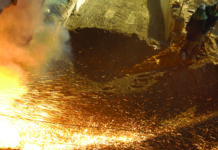
[miningmx.com] — COAL of Africa (CoAL) has made its first shipment of
coal from the Vele colliery. This follows the dispachtment of 30 rail wagons of coal at
Musina on Tuesday, destined for the Matola terminal in Maputo.
The load of approximately 1,500 tonnes of thermal coal (from what is primarily a
semi-soft coking coal resource) will be shipped and sold to Asian markets. It is part of
a test run, CoAL says, to confirm Transnet Freight Rail’s capacity to handle regular
trains from the Musina siding on the existing line.
This occasion must have seemed a long way off when the development of Vele was
delayed for 14 months; a period when CoAL became the focal point for the muddle
that is South Africa’s environmental legislation.
CoAL also faced stiff opposition from environmentalist groups that regarded its plans
to mine coal in the beautiful savannah Bushveld of the Limpopo valley, close to the
Mapungubwe world heritage site, as the last straw on the camel’s back over the effect
of unrestrained mining on South Africa’s natural resources.
CoAL was granted a new order mining right for Vele in March 2010 and was expected
to produce its first coal before the end of that year. It thought it had its regulatory
bases covered with the mining right and associated environmental management plan,
but was soon served a compliance notice by both the Department of Environmental
Affairs (DEA) and the Department of Water Affairs (DWA) for respectively falling foul
of the National Environmental Management Act (Nema) and operating without a valid
water-use licence.
This, together with the legal challenges thrown its way by the environmental
coalition, meant that development at Vele stood still for the latter part of 2010 and
much of 2011. Full-scale development of the mine only started in October after the
suspension of its water-use licence was lifted.
That CoAL managed to steer itself out of this mess bears testimony to the
determination of CEO John Wallington and his management team who, as a result,
positioned CoAL to now take advantage of the favourable prospects for coking coal
producers.
Having had the opportunity to visit Vele, it’s very notable how seriously the mine’s
management regards its obligation to only disturb the very necessary parts of the
area’s landscape. One section of the very clean site is barely noticeable from an
opposite end as trees – among them a few of Limpopo’s signature Baobabs – and
bushes obscure one’s view.
Whether this care for the natural surroundings was self-initiated or brought about by
the watchful eyes of the lobby groups, the outcome is a win for South Africa and a
blueprint for what others will be required to do in future.
For now, Vele will stick to producing 1 million tonnes per year of semi-soft coking coal
from the asset’s 680Mt resource. Wallington says no expansion should happen for the
next two to three years, while a decision to proceed will depend on the strength for
coking coal demand as well as the success of Vele’s environmental initiatives.
A more pressing priority is the development of the nearby Makhado project, of which
the first phase is envisaged to produce 2.5Mtpa. Wallington says the group has
learned from its experience at Vele, and is now “doing things by the book’ as it goes
about ticking the regulatory boxes for the project.
This process is expected to be completed by the end of the year.











